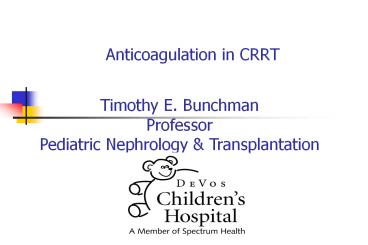Anticoagulation in CRRT - PowerPoint PPT Presentation
1 / 20
Title:
Anticoagulation in CRRT
Description:
Title: Aspen, Colorado Author: BRADLEY A WARADY, MD Description: Aspen Talk, July, 1998 Last modified by: Timothy E. Bunchman Created Date: 7/3/1997 7:31:28 AM – PowerPoint PPT presentation
Number of Views:219
Avg rating:3.0/5.0
Title: Anticoagulation in CRRT
1
Anticoagulation in CRRT
Timothy E. BunchmanProfessorPediatric
Nephrology Transplantation
2
Anti-Coagulation
- What is best?
- Can you run anticoagulation free?
- Having no anticoagulation shortens circuit life
- Will you use Heparin?
- Patient bleeding
- Platelet count (HIT)
- Will you use Citrate?
- Citrate lock
- Metabolic alkalosis
3
Anticoagulation free Protocols
- Classically occur in patients with MODS with
abnormal clotting parameters - Usually these patient are given ample amount of
platelet infusions and coagulation factors - This excessive amount of volume adds to greater
need for ultrafiltration - Final affect is clotting
4
Heparin or Citrate (Mehta data)
Saline Flushes
Filter Life (hours)
Citrate
Heparin
Mehta,RL. Regional Citrate anticoagulation for
CAVHD in critically ill patients . Kidney Int,
38 976-978, 1990.
5
Heparin ProtocolsBenefit and Risks
- Benefits
- Heparin infusion prior to filter with post filter
ACT measurement - Bolus with 10-20 units/kg Infuse at 10-20
units/kg/hr - Adjust post filter ACT 180-200 secs
- Risks
- Patient Bleeding
- Unable to inhibit clot bound thrombin
- Ongoing thrombin generation
- Activates - damages platelets / thrombocytopenia
6
Citrate How does it work
- Clotting is a calcium dependent mechanism
chelating calcium within blood will inhibit
clotting - Adding citrate to blood will bind the free
calcium (ionized) calcium in the blood thus
inhibiting clotting - Common example of this is blood banked blood
7
Citrate Mechanism of Action
- (Thanks to Peter Skippen)
8
Citrate Advantages
- No need for heparin
- Commercially available solutions exist
(ACD-citrate-Baxter) - Less bleeding risk
- Simple to monitor
- Many protocols exist
9
(Ca 0.4 x citrate rate 60 mls/hr)
(Citrate 1.5 x BFR 150 mls/hr)
Pediatr Neph 2002, 17150-154
(BFR 100 mls/min)
Normal Saline Replacement Fluid
Calcium can be infused in 3rd lumen of triple
lumen access if available.
Normocarb Dialysate
- ACD-A/Normocarb Wt range 2.8 kg 115 kg
- Average life of circuit on citrate 72 hrs (range
24-143 hrs)
10
Complications of CitrateMetabolic alkalosis
- Metabolic alkalosis due to
- citrate converts to HCO3 (1 mmol of citrate
converts to 3 mmols of HCO3)-major cause - Solutions contain 35 meq/l HCO3-minor cause
- NG losses-minor cause
- TPN with acetate component-minor cause
- Rx metabolic alkalosis by addition of an acid
load Normal Saline (pH 5.4)
11
Complications of CitrateCitrate Lock
- Seen with rising total calcium with either a
sustained or dropping patient ionized calcium - Essentially delivery of citrate exceeds hepatic
metabolism and CRRT clearance - Rx of citrate lock
- Decrease or stop citrate for 10-30 minutes then
restart at 70 of prior rate - Patients receiving multiple blood products
receive additional citrate that may not be
accounted for!
12
What is the best anticoagulant
- None
- Heparin
- Standard
- Low molecular weight
- Citrate
13
Citrate Heparin LM Hep
Hoffbauer R et al. Kidney Int. 1999561578-1583.
14
Heparin or Citrate?(M Golberg RN et al, Edmonton
PCRRT 2002)
- Heparin circuits
- 13 patients with 45 filters
- 29.4 23 hrs average length of circuit
- Citrate circuits
- 16 patients with 51 filters
- 49.1 26 hrs average length of circuit
- (p lt 0.001)
15
Filter clot free survival at fixed time intervals
according to method of anticoagulation
citrate
heparin
(data from Sheldon Tobe)
16
ppCRRT- Anticoagulation
- Center, Patient and Circuit Demographics
- Data collected from 1/1/01 through 10/31/03
- HepACG only 3 centers (1 CVVH, 2 CVVHD)
- CitACG only 2 centers
- HepACG changed to CitACG 2 centers
- 138 patients total
- 18208 hours of CRRT circuit time
- 230 hepACG circuits (52) (9468.hrs)
- 158 citACG circuits (36) (6545 hrs)
- 54 noACGcircuits (12) (2185 hrs)
17
ppCRRT Anticoagulation
(Brophy et al, submitted)
18
ppCRRT Anticoagulation
- 43/158 citACG vs 58/230 hepACG clotted (NS)
- 9 pts (hepACG) had systemic bleeding 4 led to
hepACG discontinuation - 1 pt (hepACG) developed Thrombocytopenia leading
to hepACG discontinuation - No systemic bleeding side effects were reported
with citACG 4 pts developed alkalosis and 2 pts
with hepatic failure developed citrate lock. - No correlation between circuit survival and (1)
mean hepACG rate (2) ACT/hour or (3) ACTs
less 180 seconds
19
Summary
- Many protocols exist for anticoagulation
- All have risk and benefit
- Heparin with protamine has been used but adds to
potential complications and work at bedside
20
Conclusion
- Choice of anticoagulation is best decided locally
- For the benefit of the bedside staff who do the
work come to consensus and use just one protocol - Having the protocol changed per whim of the
physician does not add to the the care of the
child but subtracts due to additional confusion
and work at bedside































